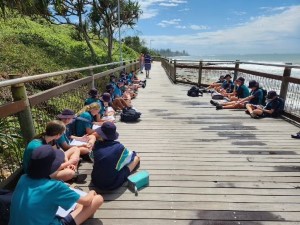This week the thread revolves around the concept of peaceful conflict resolution. Conflict in a relationship is almost a given. From a slight disagreement to a breakdown in relationships, all of us will from time to time, fall into this category. It is very normal and part of a normal healthy relationship. However, the challenge can arise when we prepare to resolve our disagreements and quite often our young people experience what we might call “big emotions.” As we mature, we are more adept at identifying and recognising how these feelings may occur and how we might deal with them. However, this is a gradual process and for younger children, it can be challenging when these big emotions appear.
Managing emotions and recognising heat moments have a big bearing on how the brain processes different situations. Perhaps the easiest way to explain this is by using the analogy of an upstairs and a downstairs brain.
The downstairs brain includes lower regions of the brain that are responsible for basic functions (like breathing and blinking) as well as impulses and emotions (like anger and fear). The upstairs brain is responsible for more intricate mental processes like planning, decision-making, self-awareness, empathy and morality. When a child’s upstairs brain is functioning well, they are more likely to be able to slow down, think before they act, regulate emotions, self-soothe and consider others’ feelings and perspectives — all important areas of healthy human functioning.
 When the upstairs and downstairs brain lose contact, we name this “flipping our lid”. We have momentarily lost contact with the rational part of our brain and big emotions are released.
When the upstairs and downstairs brain lose contact, we name this “flipping our lid”. We have momentarily lost contact with the rational part of our brain and big emotions are released.
While the downstairs brain with its strong emotions and impulses is fully built and functioning in young children, the upstairs brain is unfinished and is still under construction well into a person’s twenties. Our job as adults in children’s lives is to support the integration of the downstairs and upstairs regions of kids’ brains.
In many ways, we are building our resilience. This is not always easily done. Part of our education of students at the College is informing them of how they may recognise the roadblocks to resolution. Our You Can Do It programs fosters many practical examples of how we may connect both parts of our brain together. Students are supported in breathing, talking and remaining positive. All are simple ways to get through a challenge.
Year 4 and 5 YACHTS Showcase
Last week I, along with many parents, staff and students were invited to the library to attend the YACHTS showcase. Students have been invested in their projects around the literary classics, such as Pollyanna, The Wizard of Oz and the Lord of the Rings for the majority of this semester. The method they were able to express their learning and knowledge of the subject was only restricted by their imagination, and the breadth of how this was achieved was outstanding. We thank Mrs Julie Darr, our Learning Enrichment teacher, for her guidance in this extension opportunity. Congratulations to all involved.



Year 3 Outdoor Education
Last Friday our Year Three cohort returned excited and slightly tired from their very first Outdoor Education experience, held locally at Alexander Headlands. From all reports, the students had a fantastic time and enjoyed the learning attached to the activities and reflections from their first overnight event. We thank Mr Paul Brace, our Head of Outdoor Education for his planning prior to and delivery of such an engaging program. We also thank the many staff who attended over the two days and we are fortunate that the staff involved have given so freely of their time for the benefit of others.
Uniform and Expectations
I would like to take the opportunity to thank all students and parents for their support of the College Uniform Policy. How we manage our uniform expectations shows the community how we present and care for ourselves. A reminder that hair for all students should be always tied back if longer than the collar and that students should not be wearing hairstyles that bring undue attention to themselves. This includes “tracks” in the side of the head as well as haircuts shorter than a number two blade. Students have been reminded about expectations regarding hair and accessories this week. All hair bands are in line with the colours of the College. Shoes and socks must match the uniform of the day.
Take care and God Bless,
Mr Damian Davis, Head of Staff and Students P-5
 Usually, when a conflict arises there are two firmly held opposing views. Finding a peaceful resolution is often more about finding a third way rather than convincing someone that one position is stronger than the other. Finding the third way involves listening carefully to one another, letting go of judgments and understanding the values and perspectives that each person is bringing to the conversation. Empathy is key in this process. Learning and teaching young people to pause, suspend judgment and reflect on how the other person might be seeing the situation, helps people to learn to shift from the reactive parts of the brain to the front sections where more complex thinking such as planning, empathy, compassion and self-awareness occurs. Breathing or walking away to think about how to resolve a conflict by considering the other person’s perspectives enables a third way to be found.
Usually, when a conflict arises there are two firmly held opposing views. Finding a peaceful resolution is often more about finding a third way rather than convincing someone that one position is stronger than the other. Finding the third way involves listening carefully to one another, letting go of judgments and understanding the values and perspectives that each person is bringing to the conversation. Empathy is key in this process. Learning and teaching young people to pause, suspend judgment and reflect on how the other person might be seeing the situation, helps people to learn to shift from the reactive parts of the brain to the front sections where more complex thinking such as planning, empathy, compassion and self-awareness occurs. Breathing or walking away to think about how to resolve a conflict by considering the other person’s perspectives enables a third way to be found.












 Wishing all the cast and crew of Elf The Musical, the very best as they complete their final preparations this weekend, and embark on the Events Centre theatre next week to present a much-loved Christmas classic tale.
Wishing all the cast and crew of Elf The Musical, the very best as they complete their final preparations this weekend, and embark on the Events Centre theatre next week to present a much-loved Christmas classic tale.








 For all enquiries, please use the contact details listed below.
For all enquiries, please use the contact details listed below. For all enquiries, please use the contact details listed below.
For all enquiries, please use the contact details listed below. Sharing a common mission and ministry with Pacific Lutheran College
Sharing a common mission and ministry with Pacific Lutheran College